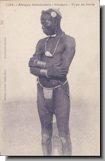The ethnic group known as the Jola, Jolla or Diola
tribe as they are known in Senegal make up 10% of the Gambian population
and are heavily concentrated in the Foni area of south west
Gambia and Casamance in Senegal as well as parts of the north
of Guinea-Bissau.
Senegal make up 10% of the Gambian population
and are heavily concentrated in the Foni area of south west
Gambia and Casamance in Senegal as well as parts of the north
of Guinea-Bissau.
Historically Jola communities and lineages are highly fragmented,
decentralised and highly autonomous and were spread out in hamlets
covering several square kilometres. They do not have a caste
system unlike say the Wolof social
hierarchy and further they had no paramount chief like the Mandinka
as rule was carried out only at the village
level. They are famous in Gambia for their exciting tribal cultural
dancing.
The Jolas of Foni call themselves Ajamat or Ajamatau and
it was the Mandinka who called them
"Jo-la" which means someone who pays back for something
given or done to them.
The Jolas are an industrious people and their various occupations included
large scale rice cultivation, honey collecting, palm wine tapping
(bounouk), fishing, oyster collecting and other agricultural activities.
Many women are employed in Gambian households as domestic maids.
Their wealth was measured in the amount of rice owned as opposed
to the Fulani who measured their wealth
in the number of cattle one possessed.
are an industrious people and their various occupations included
large scale rice cultivation, honey collecting, palm wine tapping
(bounouk), fishing, oyster collecting and other agricultural activities.
Many women are employed in Gambian households as domestic maids.
Their wealth was measured in the amount of rice owned as opposed
to the Fulani who measured their wealth
in the number of cattle one possessed.
In a typical Jola village the eldest man who founded the village
would be the head but had no power other than as a ritual head
and adjudicator in any disputes. However, in times of war or when
Jola villages were attacked villages would get together in a temporary
alliance under an acceptable warrior. This alliance would end
as soon as the war ended.
History & Origins:
Little is known about the origins of the Jolas (Diolas) because
unlike other tribes they do not traditionally have griots
who were able to pass down their ancestor's history
from one generation to the next. However, they do have musical
entertainers who recited their past but this was not passed down
to the next generation therefore reducing their collective historical
memory. They often build stockades against real or imaginary enemies
and they were protected for a long time from European influence
as they tended to inhabit thick forest woodland or swamp areas
which proved difficult for outsiders to penetrate. This is one
of the reasons so little is known about their origins.
What is known is that they are among one of the oldest existing
tribes in The Gambia. They along with other groups like the Balanta
and Pepel were already in the Casamance region of Senegal in the
13th century before moving northwards to Foni. Their migrations
tended to be sporadic, seasonal and on a smaller scale than say
the Mandinka. Over time some migrations
evolved into more permanent settlements and some of them moved
in to Baddibu, Niumi and Bathurst during the Soninke-Marabout
wars when they were attacked by the Islamist jihadists Foday Kabba
Dumbuya, Ebrima Njie and others between 1850 and 1890. The Islamists
were determined to convert the people of the region
from their animist beliefs and practices. The Jolas proved to
be the most difficult tribe to convert however, most eventually
succumbed though some doggedly held out and many who are Muslims
today still perform animist
practices.
In the 1880s a few Foni Jolas were engaged in palm wine tapping
in Bathurst. By the end of 19th century some Jola had moved to
producing groundnuts as a cash crop
and during the second world war had expanded greatly. They also
reared livestock and produced other crops
including sweet potatoes, yams and watermelon.
In 1894 Foni was put under the British Protectorate System and
was ruled by a commissioner and local native tribunal. They also
installed Mandinka chiefs to collect taxes and act as a go-between.
However, due to their stockades, fragmentary society and lack
of a clear leader or chief and their fierce local independence
the British had great difficulty penetrating their society or
making them succumb to colonial rule.
By 1900 the Jolas gradually accepted this foreign presence and
by 1905 their attitude had significantly changed and they began
to pay taxes and approach the commissioner's office with disputes
and problems. The imposed Mandinka chiefs were replaced by French
educated Jola chiefs who were more acceptable.
|
|
 Culture
& Traditions
Culture
& Traditions
 Languages
Languages

 Aku
Aku
 Fula
Fula
 Jola
Jola
 Mandinka
Mandinka
 Serahule
Serahule
 Serer
Serer
 Tukulor
Tukulor
 Wolof
Wolof
 Other Ethnic Groups
Other Ethnic Groups
|



